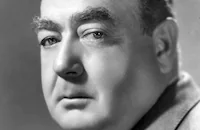Pointed Heels
Cast & Crew
A. Edward Sutherland
William Powell
Fay Wray
Helen Kane
Richard "skeets" Gallagher
Phillips Holmes
Film Details
Technical Specs

Synopsis
Robert Courtland, a wealthy theatrical producer, and Joe Clark, his dance director, are rehearsing a new musical comedy when Lora Nixon, in whom Courtland is interested, quits the production to marry young Donald Ogden, a composer. Ogden's wealthy family, however, stop his allowance, and the couple are forced to occupy a modest flat. He tries to continue work on a symphony, and Lora takes back her chorus job. Lora's brother, Dash, and his wife, Dot, scornful of his serious endeavors, taunt Donald into writing a popular song and induce Courtland to back another revue in which they have parts. Courtland persuades Donald that he is hampering Lora's chances for a career; and after a visit to Courtland's apartment, Lora decides to leave her husband. But when his song proves the hit of the show, Lora is reunited with Donald.

Director
A. Edward Sutherland
Cast

William Powell

Fay Wray

Helen Kane
Richard "skeets" Gallagher

Phillips Holmes

Adrienne Dore

Eugene Pallette
Crew
Mack Gordon
Perry Ivins
Harry M. Lindgren
Jane Loring
Max Rich
Leo Robin
Florence Ryerson
Dimitri Tiomkin
John V. A. Weaver
Richard A. Whiting
Rex Wimpy

Film Details
Technical Specs

Articles
Fay Wray (1907-2004)
She was born Vina Fay Wray, in Cardston, Alberta, Canada on September 15, 1907. Her family relocated to Arizona when she was still a toddler so her father could find employment. When her parents divorced, her mother sent her to Hollywood when Fay's eldest sister died in the influenza epidemic of 1918. The reasoning was that Southern California offered a healthier climate for the young, frail Wray.
She attended Hollywood High School, where she took some classes in drama. After she graduated, she applied to the Hal Roach studio and was given a six-month contract where she appeared in two-reel Westerns (25 minutes in length), and played opposite Stan Laurel in his pre-Oliver Hardy days.
She landed her first big role, as Mitzi Schrammell, in Erich von Stroheim's beautifully mounted silent The Wedding March (1928). It made Wray a star. She then starred in some excellent films: The Four Feathers (1929), the early Gary Cooper Western The Texan (1930), and one of Ronald Coleman's first starring roles The Unholy Garden (1931), all of which were big hits of the day.
For whatever reason, Wray soon found herself in a string of thrillers that made her one of the great screamers in Hollywood history. The titles say it all: Doctor X, The Most Dangerous Game (both 1932), Mystery of the Wax Museum, The Vampire Bat (both 1933) and, of course her most famous role, that of Ann Darrow, who tempts cinema's most famous ape in the unforgettable King Kong (also 1933).
Wray did prove herself quite capable in genre outside of the horror game, the best of which were Shanghai Madness with Spencer Tracy; The Bowery (both 1933), a tough pre-Hays Code drama opposite George Raft; and the brutal Viva Villa (1934), with Wallace Beery about the famed Mexican bandit. Yet curiously, the quality of her scripts began to tank, and she eventually found herself acting in such mediocre fare as Come Out of the Pantry (1935), and They Met in a Taxi (1936).
With her roles becoming increasingly routine, the last of which was the forgettable comedy Not a Ladies Man (1942), she decided to trade acting for domesticity and married Robert Riskin, who won two Best Screenplay Oscars® for the Frank Capra comedies It Happened One Night (1934) and Mr. Deeds Goes to Town (1936). When Riskin died in 1955, Wray found herself working to keep busy and support her three children. She landed supporting parts for films like The Cobweb (1955), Hell on Frisco Bay (1956) and Tammy and the Bachelor (1957). She also found work in television on such popular programs as Perry Mason and Wagon Train before she retired from acting all together in the mid-'60s.
To her credit, Wray did remain reasonably active after her retirement. She published her autobiography, On The Other Hand in 1989 and was attending many film festivals that honored her contribution to film, most notably in January 2003, when, at 95 years of age, she accepted in person her "Legend in Film" Award at the Palm Beach International Film Festival. Wray is survived by a son, Robert Riskin Jr.; two daughters, Susan and Victoria; and two grandchildren.
by Michael T. Toole














